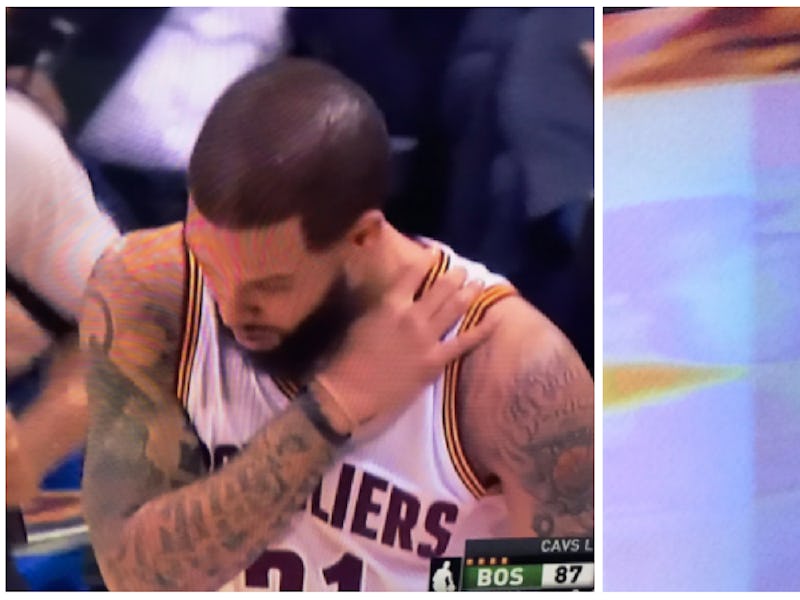Sunday night was a bad night for the Cleveland Cavaliers, but things were particularly tough for point guard Deron Williams. While the rest of his team was busy losing to the Boston Celtics in Game 3 of the Eastern Conference Finals, Williams appeared to be bearing the weight of a 1980s-era chemical concoction, known colloquially as “spray-on hair,” on his unnaturally smooth scalp.
NBA fans blasted Williams on Twitter and recalled the notorious looks of Carlos Boozer, a former teammate and Utah Jazz power forward who once admitted to trying on spray-on hair, which he said took him seven or eight tries to wash out. While Williams has yet to speak out on whether or not he was actually using the product, it wouldn’t hurt for him to know what’s in the stuff, in case he’s tempted to try again in the future.
Spray-on hair, or “hair in a can,” which made the list of Time’s 50 Worst Inventions in 2010, does largely what its name suggests: In the same way airbrushing hides facial blemishes in Photoshop, spray-on hair covers up patches of baldness on an otherwise normal, hair-covered scalp. The original formulation — Ronco’s GLH-9 (short for “Great-Looking Hair Formula #9”) is thought to be the first — was said to be made up of a liquid that dried instantly to a fine powder, which built upon itself to “grow” strands as it was sprayed onto a person’s head. In most formulations, the non-permanent chemical formulation is meant to dry with a matte, not shiny, finish so that it blends with existing hair.
In 2016, Ron Popeil, GLH-9’s inventor, explained its mechanics to MEL magazine:
“It came out in the form of a liquid. But the liquid contained little particles of powder. The liquid would dry off, and you’d be left with the powder. If you look carefully at a man’s bald spot, you’ll see little pieces of hair trying to grow up but not going anywhere. To the naked eye, you’re bald. But there are little follicles of hair still there. The powder would adhere to those little pieces of fuzz. The color itself acted as a kind of paint. So a bald spot that was white became pretty close to the color of your hair. It was as simple as that.”
But what the hell is this stuff made of? According to a website called Hairloss101, the ingredients in GLH include hydrocarbon propellant, SD alcohol 40 (a type of denatured alcohol used as a solvent), iron oxides, talc, and fumed silica. The most important components to hair building are likely to be the iron oxides, for color, and talc (the crushed-up mineral that also makes up baby powder), which is probably the structural “fiber” that GLH and related microfiber sprays uses to create the illusion of thickness on hair. Fumed silica is commonly added to paints and cosmetics to ensure even distribution.
A video by the creators of Toppik, a similar product that claims to use charged keratin in place of powder to build thickness on existing strands of hair, outlined the general mechanism by which these “microfiber hair” products work.
Particles solubilized in the spray stick to existing hair strands, giving the illusion of thickness.
Since GLH-9’s debut, brands like the aforementioned Toppik and Boozer’s choice Bigen have gained popularity, but while formulations vary between brands, they all probably use the same general principle — that is, thin hair won’t look so thin if it’s dressed in a particle coat.
What hasn’t really been addressed, however, is what happens to the tiny particles when they don’t land on hair. Are they what collect and settle on the scalp, like a wasteland of coal dust, forming an abnormally uniform and matte layer resembling a smear of shoe polish? Is this chemical oversight what’s actually responsible for the scalp-shaming that Williams has undergone since Sunday?
Again, we don’t know whether Williams actually used the stuff (maybe he’s just trying a new conditioner), but it wouldn’t be much of a surprise, considering he already made Complex’s list of athletes who need hair transplants in 2012. His health should be fine too, as far as the product’s longevity and ingredient list can attest. Rather, it’s his reputation that would take the hit if he tries it again. Perhaps this is a sign he should take a cue from his teammate LeBron James and accept his receding hairline as the call of maturity. It certainly hasn’t hurt James’s champion status.
